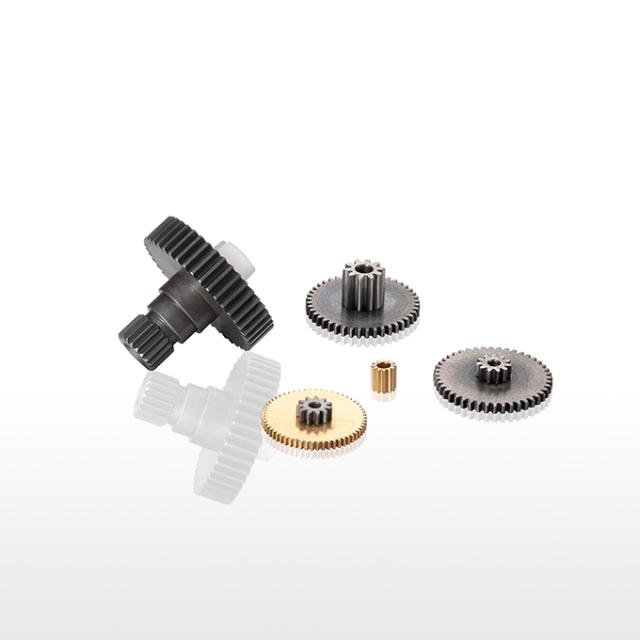What are the common faults of gears
- Author:赛仑特实业
- Origin:www.gdmotor.cn
- Time of issue:2021-12-11 08:51
- Pageviews:
(Summary description)Everyone is familiar with the application of gears, and it is often seen in life. Gear failures will occur during long-term use. Today we will take a look at the common failures.
What are the common faults of gears
(Summary description)Everyone is familiar with the application of gears, and it is often seen in life. Gear failures will occur during long-term use. Today we will take a look at the common failures.
- Categories:Technical Guide
- Author:赛仑特实业
- Origin:www.gdmotor.cn
- Time of issue:2021-12-11 08:51
- Views:0
1. Broken tooth
1) Fatigue tooth breakage: Fatigue will occur due to the combined action of stress concentration sources such as root fillet, machining tool marks, material defects, etc. crack. The cracks gradually propagate and expand, eventually leading to fatigue fracture of the gear teeth.
2) Overload broken tooth: For gears made of brittle materials such as cast iron or high-hardness alloy steel, due to severe overload or impact load, the stress on the dangerous section of the tooth root will exceed the limit value and sudden tooth breakage will occur.
3) Partial broken tooth: When the machining accuracy of the tooth surface is low, or the quality of the gear maintenance and installation is poor, the eccentric load phenomenon that one end is in contact and the other end is not in contact along the tooth surface contact line will occur. The eccentric load causes the stress at the tooth root of the partially contacted gear to increase significantly, exceeding the limit value and local tooth breakage occurs. Partial broken teeth always occur at the ends of the gears.

2. Pitting
1) Initial pitting (also called convergent pitting): usually only occurs on the soft tooth surface (HB<350). After the pitting appears, it does not continue to develop, or even disappears. The reason is that the micro-bumps gradually flatten, thereby expanding the contact area and reducing the contact stress.
2) Expansion pitting corrosion: It occurs on the hard tooth surface (HB>350). After the pitting corrosion occurs, because the tooth surface is brittle, the edge of the pit will not be flattened, but will continue to fragment until the tooth surface. completely damaged.
For split gears, the fatigue cracks on the tooth surface are ground away before they form or propagate, so there is no pitting corrosion. When the hardened gear is not heat treated properly, along the interface between the surface hardening layer and the core, the tooth surface sometimes peels off in flakes, which is called chip erosion.
3. Wear
The wear of the tooth flank is caused by metal particles, dust and sand entering the working surface of the tooth. The uneven tooth surface and poor lubrication are also the causes of tooth surface wear. In addition, misalignment, coupling wear, and torsional resonance can cause large torque changes at the gear meshing point, or increase the impact, which will accelerate wear.
After the gear is worn, the thickness of the teeth becomes thinner, the tooth profile is deformed, and the backlash becomes larger, which will cause the dynamic load of the gear to increase, which not only increases the vibration and noise, but also may lead to broken teeth.
4. gluing
Tooth surface gluing (scratch) is due to the oil film rupture of the meshing tooth surface when the relative sliding, the direct contact of the tooth surface, the instantaneous high temperature in the contact area under the action of friction and pressure, and the damage of local welding adhesion and peeling on the metal surface.
Gluing often occurs when the viscosity of the lubricating oil is too low, the operating temperature is too high, the load per unit area on the tooth surface is too large, the relative sliding speed is too high, the contact area is too small, and the rotational speed is too low (the oil cannot be brought up). After the tooth surface is glued, the wear of the tooth surface will be accelerated, and the gear transmission will soon tend to fail.
Scan the QR code to read on your phone

Address: No. 15, Century Road, Baihao Industrial Zone, Houjie Town, Dongguan City, Guangdong Province
E-mail : a0sailuntejiansudianjijin1@gdmotor.cn
Contact number:86-0769-39017383
Contact phone:86-18002601103

Scan code access
COPYRIGHT © 2021 Dongguan Silent Industry Co.,Ltd ALL RIGHTS RESERVED




 86-0769-39017383
86-0769-39017383 Search
Search




